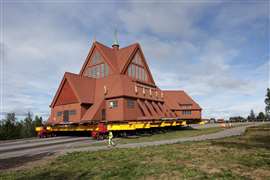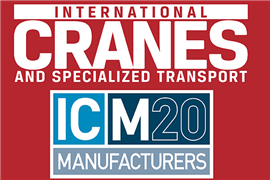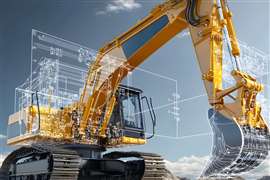Read this article in 中文 Français Deutsch Italiano Português Español
Weekly quiz: How do you move 713-tonne church? | What needs fixing on Verrazzano Narrows Bridge? | Strabag goes modular
21 August 2025
 Mammoet is working with contractor Veidekke to move a church in Kiruna, Sweden. (Photo: Reuters/Leonhard Foeger)
Mammoet is working with contractor Veidekke to move a church in Kiruna, Sweden. (Photo: Reuters/Leonhard Foeger)
It’s the Construction Briefing weekly news quiz. How much attention have you been paying to events in the world of construction over the past seven days?
1) Skanska has secured a US$249 million contract with the New York Metropolitan Transportation Authority for work on the Verrazzano Narrows Bridge. What will the project involve?
- Replacing the bridge’s suspension cables with new corrosion-resistant steel.
- Designing and installing a main cable dehumidification system, acoustic monitoring, and associated infrastructure, plus five years of maintenance.
- Widening the bridge’s spans and adding a dedicated bus lane.
2) In Sweden, the 713-tonne wooden Kiruna Church has been relocated because of ground subsidence from iron ore mining. How was the move carried out?
- The entire church was transported intact on a specially built trailer, travelling 5km at about 500 metres per hour, with the process livestreamed and accompanied by public events.
- The church has been dismantled into sections and reassembled near Kiruna’s new city centre, with no public access to the move.
- A replica church is being built 3 km away while the original remains in place due to structural fragility.
3) Germany’s housing construction sector continues to struggle amid what’s described as a “pincer grip” situation. Which pair of pressures characterises this challenge?
- Low citizen demand and an oversupply of new housing.
- Soaring construction costs and limited new work orders.
- Rapid technological disruption and an influx of unskilled migrant labour.
4) Strabag, the Austria based contractor, has launched a new modular housing product named TETRIQX to address urban housing challenges. What are the key sustainability benefits the company claims it offers?
- It cuts life-cycle CO₂ emissions by up to 50% and reduces operational heating and cooling energy needs by at least 22%.
- It reduces material usage by 25%, halves transportation emissions, and achieves certification for zero-energy operation.
- It enables carbon-neutral construction by using only recycled steel and offers full onsite renewables.
5) In the UK, JSM Group has developed a patented system known as NICE (Non Intrusive Cable Extraction) for decommissioning underground power cables. What is the principal innovation of this method?
- It uses robotic tunnelling to install a new conduit and then extracts the cable in segments.
- It eliminates continuous trenching by extracting the cable through small entry and exit pits, reducing excavation by 80–90%.
- It melts the surrounding soil with plasma to liquefy around the cable and pull it out intact.
STAY CONNECTED


Receive the information you need when you need it through our world-leading magazines, newsletters and daily briefings.
CONNECT WITH THE TEAM











